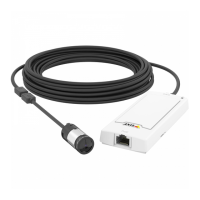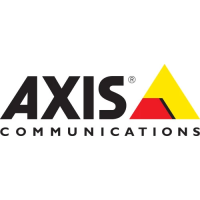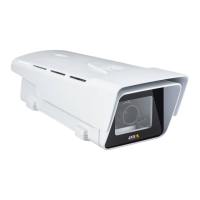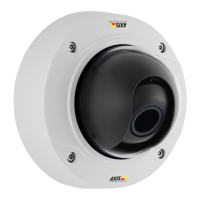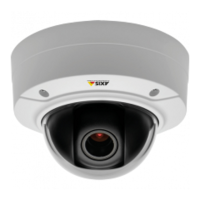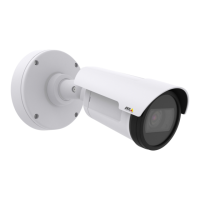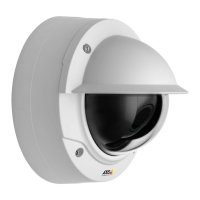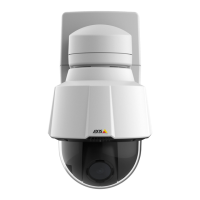
Do you have a question about the Axis P5624-E Mk II and is the answer not in the manual?
| Model | Axis P5624-E Mk II |
|---|---|
| Image Sensor | 1/2.8" Progressive scan RGB CMOS |
| Audio Compression | AAC, G.711, G.726 |
| Audio Support | Two-way audio |
| Type | PTZ Network Camera |
| Resolution | 1920 x 1080 |
| Frame Rate | 50/60 fps |
| Pan/Tilt | Pan: 360°, Tilt: 180° |
| Video Compression | H.264, MJPEG |
| Security | Password protection, IP address filtering |
| Power | PoE+ (IEEE 802.3at) |
| Operating Temperature | 50 °C |
| Ingress Protection | IP66 |
Details compliance with European directives (EMC, LVD, RoHS), USA FCC rules, and Canadian standards.
Discusses legal aspects related to video surveillance and product usage.
Outlines the company's responsibility, limitations, and intellectual property rights.
Warns against unauthorized changes and lists trademark acknowledgments.
Covers compliance with safety standards for information technology equipment.
Details the CR2032 lithium battery for RTC and replacement instructions.
Provides guidance on proper disposal according to local laws and WEEE directive.
Lists contact details, support resources, and warranty information.
Defines DANGER, WARNING, CAUTION, and NOTICE hazard levels.
Defines Important and Note message levels for user guidance.
Identifies and describes the various connectors and buttons on the product.
Details the RJ45 Ethernet connector and its PoE+ capability.
Provides instructions and warnings for using the SD card slot.
Explains the functions of the control and power buttons.
Lists and explains the meaning of the status LED indicator lights.
Details the steps to access the product's interface via a web browser.
Explains how to configure the product for access over the internet.
Instructs users on setting a secure password for the root administrator account.
Introduces the Live View page, its layout, and available controls.
Explains snapshots, Gatekeeper, Manual Trigger, and AMC toolbar functions.
Covers Pan/Tilt/Zoom controls and user management for PTZ access.
Describes PTZ controls, focus window setup, and calibration.
Explains the focus recall feature for saving and recalling focus settings in specific areas.
Details the procedures for adding and removing focus recall areas.
Covers H.264 compression and its benefits for bandwidth and quality.
Describes the MJPEG format using still images for video streams.
Recommends AXIS Media Control for viewing live video in Internet Explorer.
Shows the AMC version and component details.
Lists other methods for accessing video, like Motion JPEG server push and QuickTime.
Provides shortcuts to essential setup settings like Users, TCP/IP, Date & Time, and Video Stream.
Explains how to configure video streams via Image, H.264, Zipstream, and MJPEG tabs.
Describes the pixel counter feature for image analysis and size requirements.
Covers resolution, compression, rotation, and frame rate settings for video images.
Explains H.264 compression, frame types, GOP length, and profiles (Baseline, Main, High).
Details bitrate control methods, variable bitrate, and maximum bitrate settings.
Explains Zipstream for bitrate reduction, bandwidth saving, and storage optimization.
Advises on recommended bitrate reduction settings for different scenarios.
Discusses MJPEG bandwidth control via frame size and default settings.
Explains stream profiles and advanced camera settings like image appearance and white balance.
Details white balance adjustment and WDR for balanced imaging in varying light.
Explains exposure, backlight compensation, exposure value, shutter speed, and exposure zones.
Details how shutter speed and gain affect image quality and noise, and how to configure them.
Describes the image freeze function for PTZ movements.
Explains the IR cut filter function for day and night vision modes.
Guides on adding text overlays, including date, time, and custom text with modifiers.
Details how to include overlay text as part of an action rule trigger.
Explains how to display pan/tilt position using text overlays with modifiers.
Covers adding static overlay images like logos, specifications, and upload process.
Describes how to scale and position overlay images on the video stream.
Allows setting the default video viewer for different browsers.
Covers viewer toolbar display, H.264 decoder installation, crosshair, joystick mode, and recording button.
Explains how to add custom links to the Live View page for scripts or web pages.
Covers defining, accessing, and adding preset camera positions.
Explains how to display preset position names in video overlays.
Describes setting the camera's home position and automatic return features.
Further explains the focus window and how to reset the pan coordinate system.
Explains Gatekeeper and guides on creating guard tours for automated camera movement.
Covers editing and deleting existing guard tours.
Explains OSDI zones and setting PTZ limits, including E-flip and near focus.
Explains PTZ speed, zoom features, and configuring panel shortcut buttons.
Describes enabling/disabling PTZ controls and the PTZ control queue system.
Explains shock detection and sensitivity settings for tamper or impact detection.
Covers configuring motion detection zones, parameters, and actions.
Details parameters like Object Size, History, and Sensitivity for motion detection.
Explains how to obtain, install, and upload licenses for applications.
Discusses considerations for upgrading, restarting, and restoring applications.
Notes that applications and settings are removed upon factory default reset.
Details creating action rules with triggers, conditions, and actions like recording or notifications.
Lists various triggers for action rules, including hardware, input signal, PTZ, storage, system, and time events.
Lists available actions and how to define recipients for notifications.
Lists supported recipient types like Email and FTP.
Details protocols like SFTP, HTTP, HTTPS, Network Share, and TCP for sending data.
Guides on configuring email recipients using listed providers or custom SMTP servers.
Explains how to create custom schedules for triggering action rules.
Details setting up recurring triggers for action rules at specific intervals.
Guides on accessing and filtering recorded video files.
Explains how to play back recorded video clips.
Details how to export recordings as video clips in Matroska format.
Guides on configuring continuous video recording to a storage device.
Details managing user access levels, administrators, operators, and viewers.
Explains ONVIF support and configuring IP address filtering.
Guides on HTTPS and IEEE 802.1X for secure network access.
Discusses certificates for authentication, HTTPS, and IEEE 802.1X.
Covers configuring date and time settings, including synchronization with NTP servers.
Details basic TCP/IP settings, including IPv4 and IPv6 address configuration.
Explains the ARP/Ping service for assigning IP addresses.
Provides step-by-step instructions for assigning an IP address using ARP/Ping.
Describes AVHS and Dynamic DNS for remote internet access to video.
Covers DNS, NTP, Host Name, Link-Local IPv4, HTTP, and HTTPS port configurations.
Explains NAT traversal for making the product available from outside the LAN.
Details FTP server, RTSP server, and SOCKS proxy protocol configurations.
Covers Quality of Service settings and UPnP support for network detection.
Covers configuring SNMP for remote management and event traps.
Details SD card file systems, status checks, and settings for removing or locking recordings.
Provides instructions for safely mounting and unmounting the SD card.
Guides on formatting the SD card manually or automatically.
Explains how to encrypt data on the SD card for security.
Details adding network storage like NAS for recordings.
Explains how to restart the product and restore factory default settings.
Provides info on support, system status, and generating logs/reports.
Covers using custom scripts for advanced customization.
Explains uploading files and using Plain Config for advanced settings.
Advises checking firmware and details the upgrade process.
Lists common problems like firmware failure and IP address issues.
Addresses IP conflicts, browser access, and certificate errors.
Discusses router configuration, firewall protection, and local vs. external accessibility.
Troubleshoots issues with H.264 streaming, AMC, and multicast.
Addresses poor H.264 rendering, color differences, and low frame rates.
Covers general video issues and unexpected motion detection triggers.
Troubleshoots storage, recording, SD card, and low temperature issues.
Explains PTZ error overlays and power supply issues for camera and motors.
Discusses factors affecting performance, like resolution, bandwidth, CPU load, and network utilization.

